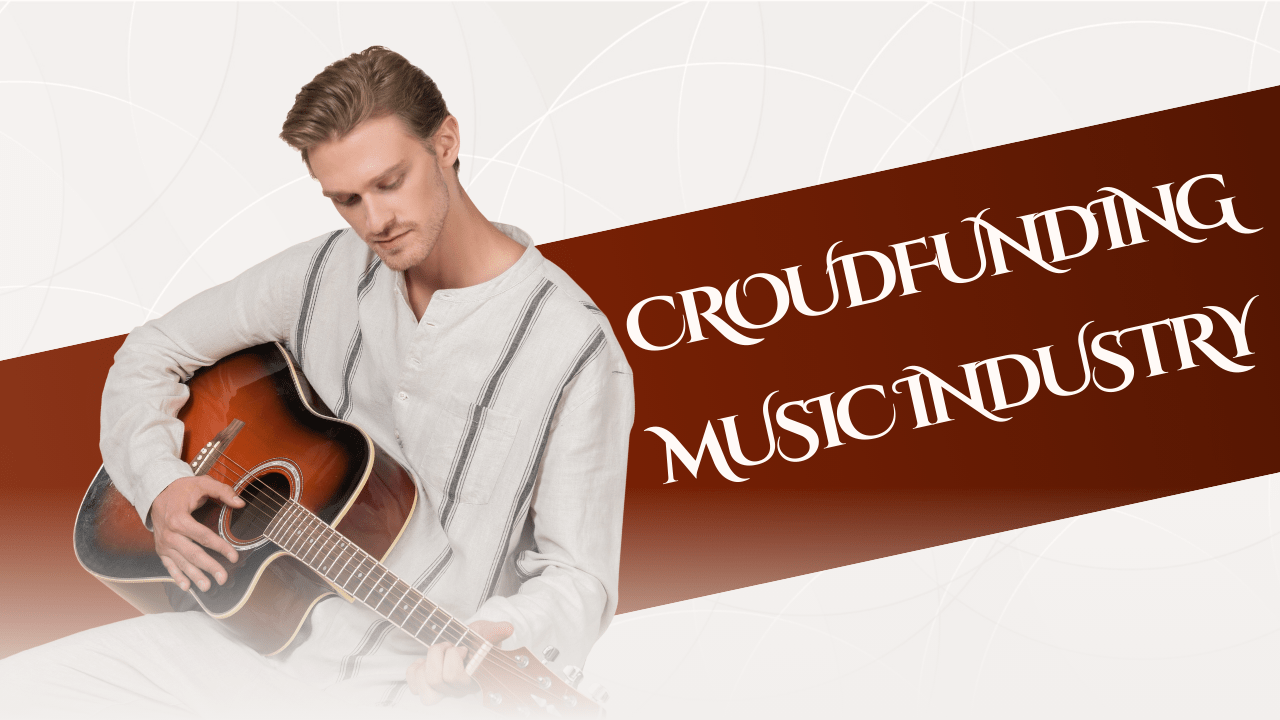The music industry has changed a lot over the years. Digital platforms and social media have transformed how artists connect with their fans. These changes have also affected how artists distribute their music and sustain their careers. Crowdfunding is one of the biggest changes in recent times. It allows musicians to connect directly with their fans to fund projects. In this blog, we’ll explore how crowdfunding is changing the music industry. We will look at its benefits and challenges, and how artists can use it to bring their music to life.
The Rise of Crowdfunding in the Music Industry
The Early Days of Crowdfunding
Crowdfunding is not a new idea. The concept of collecting small amounts of money from many people has been around for a long time. However, the digital age gave crowdfunding a new shape. The music industry was quick to adopt this model. Fans began supporting their favorite artists even before crowdfunding platforms existed.
In the early 2000s, the internet helped crowdfunding grow. Websites like ArtistShare, launched in 2003, were among the first to allow musicians to raise money directly from their fans. ArtistShare focused on jazz musicians. It offered fans exclusive access to the creative process in exchange for financial support. This model worked well and set the stage for modern crowdfunding platforms.
The Impact of Digital Platforms
Social media and digital distribution platforms like YouTube, Spotify, and Bandcamp have further boosted crowdfunding in the music industry. These platforms allowed artists to reach a global audience without relying on record labels. This change gave more power to the artists. As a result, crowdfunding became a popular option for financing music projects.
Crowdfunding platforms such as Kickstarter, Indiegogo, and Patreon became strong tools for musicians. These platforms allowed artists to share their ideas, set financial goals, and offer rewards to their supporters. Early successes in crowdfunding showed that fans were willing to support their favorite artists directly. This approach bypassed traditional industry gatekeepers.
Why Crowdfunding is Growing in Popularity
In the past, artists needed record labels to fund production, marketing, and distribution. This system often had major drawbacks. Artists lost creative control and faced unfavorable contracts. They were also pressured to produce music that was commercially viable, often at the cost of their artistic vision.
Crowdfunding offers a different path. It allows musicians to keep full control over their work. This model empowers artists to create without compromise, supported directly by their fans. As a result, crowdfunding has become a popular choice for artists seeking financial independence and creative freedom.
Success Stories and Their Impact
Several artists have successfully used crowdfunding to fund their projects. Amanda Palmer, an American singer-songwriter, is one of the most notable examples. In 2012, she raised over $1.2 million on Kickstarter to fund her album and art book. Her campaign showed that crowdfunding can be a powerful tool for musicians.
Another early example is the British band Marillion. In the late 1990s, before platforms like Kickstarter existed, the band raised $60,000 from fans to fund a North American tour. This success highlighted the power of fan support. It also inspired other artists to explore crowdfunding as a way to finance their music.
These success stories show how crowdfunding has democratized the music industry. It gives artists the freedom to create without the limits of traditional financing. This has led to a more diverse and vibrant music scene.
How Crowdfunding Works for Musicians
Picking the Right Crowdfunding Platform
One of the first steps in starting a crowdfunding campaign is picking the right platform. There are several options, each with its own strengths. Some of the most popular platforms for music crowdfunding include:
- Kickstarter: Known for its all-or-nothing funding model. A project only receives funds if it reaches its goal. This platform is ideal for artists with a clear project and budget. It’s especially useful for one-time projects like album releases, music videos, or tours.
- Indiegogo: Offers more flexibility with both fixed and flexible funding options. This means that even if a campaign does not reach its goal, artists can still keep the funds raised. Indiegogo is great for artists who want more control over their campaigns and may have multiple projects running.
- Patreon: Unlike Kickstarter and Indiegogo, Patreon is a subscription-based model. Fans, or patrons, provide ongoing support, often in exchange for regular content updates or exclusive access. This platform is ideal for artists who produce continuous content, like music videos or live streams.
- PledgeMusic: Although no longer operational, PledgeMusic was once a popular platform for musicians. Its focus was on offering fans unique experiences in return for their support. This model paved the way for similar platforms and showed the importance of fan engagement in crowdfunding.
Each platform has its own rules, fees, and audience. So, artists need to choose the platform that best fits their goals and audience.
Setting Clear Goals and Rewards
A successful crowdfunding campaign starts with clear financial goals. These goals should cover all project costs, including production, marketing, distribution, and rewards. Underestimating the needed funds can lead to financial problems, which can harm the project and lose the trust of backers.
Rewards are a key part of attracting and motivating backers. These rewards should be tiered, offering something for every level of support. Common rewards include digital downloads, physical copies of the album, exclusive merchandise, and personal experiences like music lessons or private performances. The key is to offer rewards that are valuable to the backer and manageable for the artist.
Unique and creative rewards can also set a campaign apart. For example, offering a limited edition vinyl pressing, handwritten lyrics, or a custom song can create a sense of exclusivity. However, artists must make sure they can deliver these rewards on time and within budget.
Building a Strong Community
Crowdfunding is a great way to build and engage a dedicated fanbase. However, this requires ongoing effort both before and during the campaign. Social media, email newsletters, and personal networks are essential for promoting the campaign and keeping supporters engaged.
Artists should use these platforms to share their stories, provide updates, and create a sense of community around their projects. Behind-the-scenes content, like studio sessions or songwriting processes, can give fans a deeper connection to the project and encourage them to contribute.
Collaborating with influencers, bloggers, or other artists can also help expand the campaign’s reach. These collaborations can introduce the project to new audiences and create more buzz. Hosting live Q&A sessions, releasing teaser content, or offering early access to new music are other ways to keep the momentum going throughout the campaign.
The Benefits of Crowdfunding for Artists
Creative Freedom
One of the biggest reasons artists choose crowdfunding is the creative freedom it offers. Traditional record labels often set strict guidelines on the type of music artists can produce. They focus on what will sell rather than what is artistically fulfilling. This can stifle creativity.
Crowdfunding allows artists to create without these limits. They can explore new genres, try new sounds, or produce concept albums that might not fit mainstream music. This freedom can lead to more innovative and diverse music, which enriches the industry.
Since the funding comes directly from fans, artists can also gauge interest in their ideas before fully committing. This direct feedback loop helps artists create music that resonates more with their audience.
Stronger Fan Relationships
Crowdfunding is not just about raising money. It’s also about building and strengthening relationships with fans. By involving fans in the creative process, artists can create a sense of ownership and loyalty. This connection can lead to a more engaged fanbase that supports the artist for the long term.
Fans who contribute to a crowdfunding campaign are often more invested in the artist’s success. They are likely to promote the project and the artist within their networks. This organic promotion can be invaluable, especially for independent artists with limited marketing budgets.
The rewards offered through crowdfunding can also deepen these relationships. Personalized rewards, such as a phone call with the artist or a signed album, create memorable experiences for fans. These interactions can turn casual listeners into lifelong supporters.
Financial Independence and Control
In the traditional music industry model, record labels usually pay for production, marketing, and distribution. In return, they take a large share of the profits and often keep ownership of the music rights. This can leave artists with little control over their work and small financial returns.
Crowdfunding changes this model. It gives artists full financial control and ownership of their music. By raising funds directly from fans, artists can cover project costs without giving up ownership or a large percentage of earnings. This financial independence allows artists to make decisions based on their vision rather than the demands of a label.
Successful crowdfunding campaigns can also lead to more opportunities. A well-funded project with strong fan support can attract attention from industry professionals, media outlets, and sponsors. This increased visibility can open doors for further career growth.
Lower Financial Risk
While crowdfunding has its challenges, it can reduce some of the financial risks linked to traditional music production. In the past, artists often took out loans or signed tough contracts to fund their projects. If the project didn’t generate enough revenue, the artist could end up with heavy debt.
Crowdfunding lets artists test their project’s viability before fully committing. If a campaign doesn’t reach its goal, the artist can rethink their strategy, gather feedback, and try again with a new approach. This model reduces financial risk for artists since they don’t need to proceed with a project that lacks support.
The all-or-nothing funding model used by platforms like Kickstarter also ensures that artists only move forward with fully funded projects. This guarantees they have the resources needed to complete the project and deliver on their promises to backers.
Real-Time Market Testing
Another benefit of crowdfunding is the ability to test the market in real-time. Artists can present their ideas to their audience and get immediate feedback. If a project gains support quickly, it’s a sign that there is demand for that music. If a campaign struggles, it may signal that the concept needs to be adjusted.
This real-time feedback helps artists make informed decisions. They can adjust their approach, change their marketing strategy, or even pivot to a different concept based on backer responses. This process can lead to a more successful final product.
Challenges of Crowdfunding in Music
Standing Out in a Crowded Market
As crowdfunding grows more popular, the number of campaigns has increased. This has made it harder for artists to stand out. With so many projects seeking attention, it can be tough for new or lesser-known artists to capture interest.
To overcome this, artists need to invest time in crafting a strong campaign. This includes creating a clear and engaging presentation, setting realistic goals, and offering appealing rewards. Artists also need to be proactive in promoting their campaign across different channels. Social media, email marketing, and word-of-mouth are all essential for reaching potential backers.
Managing Expectations
Crowdfunding creates a direct link between artists and their backers. When fans contribute to a project, they expect the artist to deliver on their promises. This can create pressure, especially if unexpected challenges arise during the project.
Artists need to be transparent with their backers throughout the campaign. Regular updates, clear communication about any delays, and a plan for delivering rewards are crucial for maintaining trust.
Failing to meet expectations can result in disappointed backers and negative reviews. In some cases, it could also lead to legal issues if backers feel misled.
The Workload
Running a successful crowdfunding campaign takes a lot of time and effort. From planning the campaign to promoting it and managing backer communications, the workload can be overwhelming. This is especially true for independent artists who may not have a team to support them.
Artists need to be ready to handle all aspects of the campaign. This includes marketing, customer service, project management, and financial planning. This can be challenging if the artist is also recording or performing.
One way to manage the workload is to break the campaign into smaller tasks and set a realistic timeline. Delegating tasks to trusted team members can also help. However, it’s important for artists to stay engaged throughout the campaign to ensure its success.
Reward Fulfillment
Delivering rewards to backers can be one of the most challenging parts of crowdfunding. Artists need to budget carefully to cover the costs of producing and shipping rewards. They must also manage the logistics of packaging and sending physical items. This can be time-consuming and costly, especially for international backers.
Delays in fulfilling rewards can frustrate backers and damage the artist’s reputation. To avoid this, artists should plan the reward fulfillment process in advance. This includes sourcing materials, setting production timelines, and estimating shipping costs. Clear communication with backers about delivery times is also key to maintaining trust.
Financial Management
While crowdfunding offers financial independence, it also requires careful financial management. Artists need to budget accurately for all aspects of the project. This includes production costs, reward fulfillment, and platform fees. Failing to do so can lead to financial problems and strain the artist’s relationship with backers.
Artists also need to be accountable for the funds they receive. This means keeping detailed records of expenses and managing funds responsibly. Some platforms, like Patreon, offer tools for tracking income. However, artists should also consider working with a financial advisor to ensure their finances are in order.
Tips for a Successful Crowdfunding Campaign
Build a Fanbase First
One of the key factors in a successful crowdfunding campaign is a strong fanbase. Before launching a campaign, artists should focus on building and nurturing their fan community. This can be done through regular social media engagement, email newsletters, and live performances.
Engaging with fans on a personal level, sharing behind-the-scenes content, and offering exclusive access can help build loyalty. When fans feel connected to an artist’s journey, they are more likely to support a crowdfunding campaign.
Tell a Compelling Story
A successful crowdfunding campaign is built on a compelling story. Artists should share their passion, vision, and the reasons why their project matters. This story helps potential backers connect with the project emotionally, increasing their likelihood of contributing.
The story should highlight the artist’s journey, the inspiration behind the project, and the impact it will have. Artists should also explain how the funds will be used and what backers can expect in return. A well-crafted story, combined with clear visuals and a call to action, can make a campaign stand out.
Offer Unique Rewards
While digital downloads and merchandise are common rewards, offering unique experiences can set a campaign apart. These could include private concerts, personalized songs, or a day in the studio with the artist. Unique rewards not only attract more backers but also create memorable experiences that strengthen the fan-artist relationship.
Artists should also consider offering exclusive, limited-edition items only available through the crowdfunding campaign. This creates urgency and encourages fans to contribute before the opportunity passes.
Communicate Clearly and Often
Communication is key to a successful crowdfunding campaign. Artists should provide regular updates on the campaign’s progress. This includes any milestones, challenges, and plans moving forward. Keeping backers informed and engaged throughout the campaign is crucial.
Even after the campaign ends, artists should continue to communicate with backers about the project’s progress. Transparency and honesty are essential for building trust and maintaining a positive relationship with supporters.
Plan Reward Fulfillment Carefully
Artists need to plan carefully for reward fulfillment. This includes budgeting for production, shipping, and any other costs involved in delivering rewards. Delays or issues with fulfillment can harm an artist’s reputation. It’s important to be realistic about timelines and to communicate any changes to backers promptly.
One way to streamline fulfillment is to work with third-party services that specialize in handling crowdfunding rewards. These companies can manage the logistics of packaging and shipping, allowing artists to focus on their creative work.
The Future of Crowdfunding in Music
Growth of Crowdfunding
Crowdfunding is likely to become even more integrated into how artists fund and produce their work. The success of early adopters has shown that this model works. More artists are exploring crowdfunding as a primary or supplementary source of funding.
As digital platforms grow and direct fan engagement becomes more important, crowdfunding will continue to play a key role in the music industry’s future. We can expect to see more diversity and innovation in the music being produced.
Beyond Traditional Projects
While crowdfunding has mostly been used for albums, tours, and music videos, its potential goes beyond these projects. Artists are starting to use crowdfunding for new types of projects. These include immersive experiences, social causes, or community-driven projects related to their music.
For example, some artists use crowdfunding to fund environmental initiatives, support charities, or create multimedia art installations that go with their music. As crowdfunding evolves, the possibilities for artists will continue to grow, offering new opportunities for creativity and social impact.
Integration with New Technology
As technology advances, we will see more integration of crowdfunding with new tools like blockchain, virtual reality, and artificial intelligence. These technologies can improve the crowdfunding experience for both artists and backers. They offer new ways to engage with music and support creative projects.
For example, blockchain could make transactions more secure, while virtual reality could offer immersive experiences as part of crowdfunding rewards. Artificial intelligence could help artists manage campaigns, analyze data, and improve their crowdfunding strategy.
Crowdfunding as a Long-Term Strategy
For many artists, crowdfunding is becoming a long-term strategy for sustaining their careers. Platforms like Patreon allow artists to build a steady income through ongoing fan support. This provides financial stability and lets them focus on their creative work.
As more artists adopt this approach, crowdfunding is likely to become a central part of the music industry’s ecosystem. It offers a sustainable model that aligns with the values of independence, creativity, and direct fan engagement that define today’s music landscape.
Conclusion
Crowdfunding is a powerful force in the music industry. It allows artists to connect directly with fans and raise funds for their projects. Crowdfunding offers creative freedom, financial independence, and strong community engagement. While it has its challenges, the benefits are clear for artists willing to put in the work.
As the music industry evolves, crowdfunding will play an increasingly important role in how music is funded, produced, and shared. Whether you’re a new artist launching your first album or an established musician exploring new ideas, crowdfunding offers a flexible and empowering way to bring your music to life.
The future of music is being shaped by artists who take control of their careers and engage with their fans in new ways. Crowdfunding is at the heart of this change, offering a platform for artists to create, connect, and succeed in a constantly evolving industry.
For further reading, explore these related articles:
- How to Get in the Music Industry as a Rapper: A Step-by-Step Guide
- Understanding Recording Contracts: A Comprehensive Guide for Musicians
- How to Earn Money from Spotify: A Comprehensive Guide for Musicians
For additional resources on music marketing and distribution, visit Deliver My Tune.






